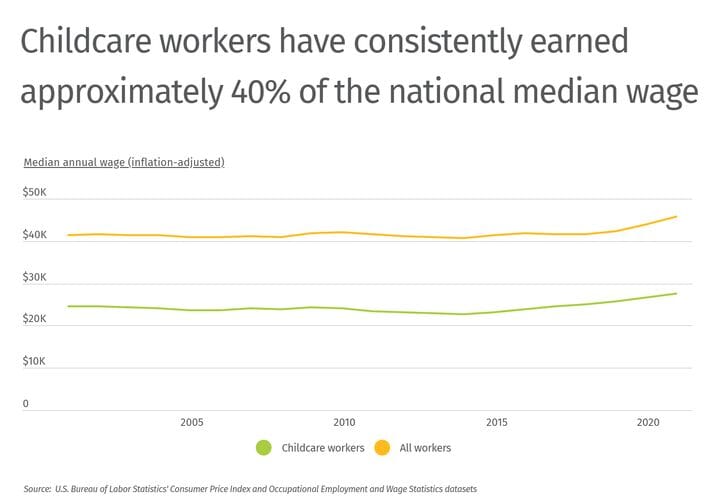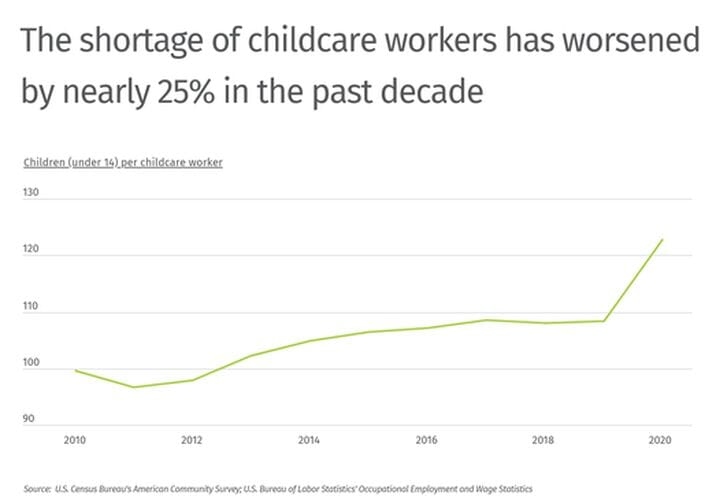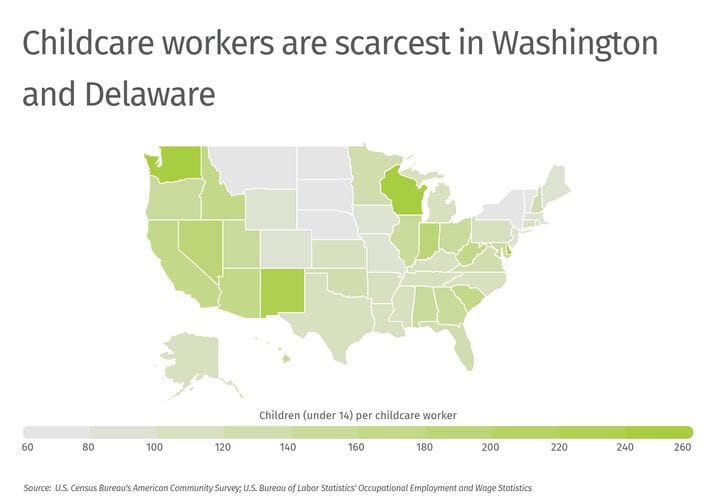Cities With a Lack of Childcare Workers

Over the last two and a half years, the COVID-19 pandemic put a spotlight on the importance of childcare to the U.S. economy.
Throughout the pandemic, stressed-out families struggled to find reliable childcare as many providers shut down abruptly due to COVID exposures. This forced many parents and caretakers to take unplanned leave, attempt to work and care for children simultaneously, or to leave the workforce altogether. Recent research from the U.S. Chamber of Commerce Foundation estimates that as many as 40% of parents have had job decisions significantly affected by childcare issues, while gaps in care result in hundreds of millions of dollars in lost economic productivity in each state each year.
Childcare is an industry that has long faced economic challenges. Many providers must survive on profit margins under 1%, even as the average family with young children pays more than 13% of income to childcare costs. And the difficult business model of childcare offers few solutions for the industry’s most significant challenge: hiring, retaining, and paying good wages to early educators.

Despite childcare workers’ vital role in the economy, compensation in the field lags far behind many other professions. A typical childcare worker in the U.S. earned an hourly rate of $13.22 in 2021, which equates to $27,490 annually for full-time workers. In comparison, the median wage for all professions was $22 per hour, or $45,760 annually—approximately 60% higher. Wages in early care and education are especially low given that most childcare workers have at least some college education.
Wages make it difficult for childcare providers to find and retain qualified staff. Many institutions of higher education steer students away from credentials that would lead to a career in the sector because compensation is so low. Estimates of employee turnover in childcare centers range from 26 to 40% annually. The pandemic exacerbated workforce challenges for the industry, as providers faced increased COVID exposure and employers in other industries saw significant wage increases.

The workforce shortage in childcare has left providers with insufficient staff to meet families’ needs. States vary widely regarding the minimum age a child must be to legally stay home alone—the highest, most restrictive limit being 14 in Illinois. According to data from the Bureau of Labor Statistics, from 2010 to 2019, the number of children under 14 per childcare worker in the U.S. increased from 99.6 to 108.4. With heavy attrition in the sector after the onset of the COVID-19 pandemic, that figure jumped to 122.9 in 2020.
TRENDING
It’s as important now as ever to keep the air in your home clean and free of airborne particles like mold, bacteria, and those that carry viruses—especially for those with young children or a respiratory condition. Replace your home air filters every 3–6 months, and consider using Filterbuy’s MERV 13 air filters for the strongest protection you can get.

Some locations have been able to better navigate the shortage of childcare workers than others. States in the upper central U.S. tend to have more favorable ratios, led by North Dakota and Nebraska at 48.8 and 57.2 children per worker, respectively. Several northeastern states including New York, Vermont, and New Jersey also have relatively low ratios. At the other end of the spectrum, four states—Washington, Delaware, Wisconsin, and New Mexico—have more than 200 children per childcare worker.
At the metro level, compensation may also explain why some cities have higher numbers of children per childcare worker. Many of the cities with the highest ratios have wages lower than the national median, and even the cities that defy these trends, like Seattle and San Jose, are high-cost locations where a childcare worker’s wages are not enough to live comfortably on.
The data used in this analysis is from the U.S. Bureau of Labor Statistics and the U.S. Census Bureau. To determine the locations with a lack of childcare workers, researchers at HowtoHome.com calculated the number of children per childcare worker and ranked them from highest to lowest. In the event of a tie, the location with the greater number of total children was ranked higher.
Here are the U.S. metropolitan areas with the greatest lack of childcare workers.

Large Metros With a Lack of Childcare Workers

15. Virginia Beach-Norfolk-Newport News, VA-NC
- Children per childcare worker: 142.1
- Total children (under 14): 325,366
- Total childcare workers: 2,290
- Median annual wage for childcare workers: $21,250

14. Oklahoma City, OK
- Children per childcare worker: 145.8
- Total children (under 14): 287,168
- Total childcare workers: 1,970
- Median annual wage for childcare workers: $20,890

13. Cleveland-Elyria, OH
- Children per childcare worker: 147.2
- Total children (under 14): 354,814
- Total childcare workers: 2,410
- Median annual wage for childcare workers: $22,130

12. Tampa-St. Petersburg-Clearwater, FL
- Children per childcare worker: 147.4
- Total children (under 14): 517,441
- Total childcare workers: 3,510
- Median annual wage for childcare workers: $23,210

11. Los Angeles-Long Beach-Anaheim, CA
- Children per childcare worker: 148.3
- Total children (under 14): 2,380,073
- Total childcare workers: 16,050
- Median annual wage for childcare workers: $30,560

10. Chicago-Naperville-Elgin, IL-IN-WI
- Children per childcare worker: 152.9
- Total children (under 14): 1,778,703
- Total childcare workers: 11,630
- Median annual wage for childcare workers: $25,810

9. New Orleans-Metairie, LA
- Children per childcare worker: 158.5
- Total children (under 14): 236,108
- Total childcare workers: 1,490
- Median annual wage for childcare workers: $19,530

8. Portland-Vancouver-Hillsboro, OR-WA
- Children per childcare worker: 161.0
- Total children (under 14): 438,035
- Total childcare workers: 2,720
- Median annual wage for childcare workers: $30,120

7. Jacksonville, FL
- Children per childcare worker: 161.2
- Total children (under 14): 286,959
- Total childcare workers: 1,780
- Median annual wage for childcare workers: $23,920

6. Orlando-Kissimmee-Sanford, FL
- Children per childcare worker: 168.1
- Total children (under 14): 462,166
- Total childcare workers: 2,750
- Median annual wage for childcare workers: $21,190

5. Las Vegas-Henderson-Paradise, NV
- Children per childcare worker: 206.2
- Total children (under 14): 430,906
- Total childcare workers: 2,090
- Median annual wage for childcare workers: $21,700

4. Riverside-San Bernardino-Ontario, CA
- Children per childcare worker: 208.8
- Total children (under 14): 979,105
- Total childcare workers: 4,690
- Median annual wage for childcare workers: $30,310

3. San Jose-Sunnyvale-Santa Clara, CA
- Children per childcare worker: 230.8
- Total children (under 14): 364,601
- Total childcare workers: 1,580
- Median annual wage for childcare workers: $30,780

2. Indianapolis-Carmel-Anderson, IN
- Children per childcare worker: 240.3
- Total children (under 14): 420,605
- Total childcare workers: 1,750
- Median annual wage for childcare workers: $23,320

1. Seattle-Tacoma-Bellevue, WA
- Children per childcare worker: 265.7
- Total children (under 14): 706,738
- Total childcare workers: 2,660
- Median annual wage for childcare workers: $35,240
Detailed Findings & Methodology
The data used in this analysis is from the U.S. Bureau of Labor Statistics’ Occupational Employment and Wage Statistics (2020) and the U.S. Census Bureau’s American Community Survey (2020). To determine the locations with a lack of childcare workers, researchers at HowtoHome.com calculated the number of children per childcare worker and ranked them from highest to lowest. In the event of a tie, the location with the greater number of total children was ranked higher. For the purpose of this analysis, children were defined as those under 14. To improve relevance, only metropolitan areas with at least 100,000 residents were included, and metros were grouped into cohorts based on population size: small (100,000–349,999), midsize (350,000–999,999), and large (1,000,000 or more).
https://infogram.com/1pwx030mqrkv65av05evy7j2g6s9rlr01nk?live



